Have you noticed specific behavior in your Labrador that leaves you questioning why they do it? You’re not alone, as almost every owner will say that their dog has exhibited at least one common Labrador behavior problem.
Common Labrador behavior problems are:
- Mouthing / Play biting
- Destructive chewing
- Excessive eating
- Separation anxiety
- Marking in the house
- Barking at other dogs
- Rolling in fox poop
- Resource guarding
Don’t throw in the towel yet, though, because most common Labrador behavior problems can be resolved with the correct training, eliminating cues, sufficient exercise, or the intervention of a specialist vet or dog behaviorist in extreme cases – who can also teach YOU how to train.
This all-new guide will explore common behavior problems in Labrador Retrievers. You’ll also learn practical ways, including tips and tricks on preventing or eliminating them for good. Let’s get started!
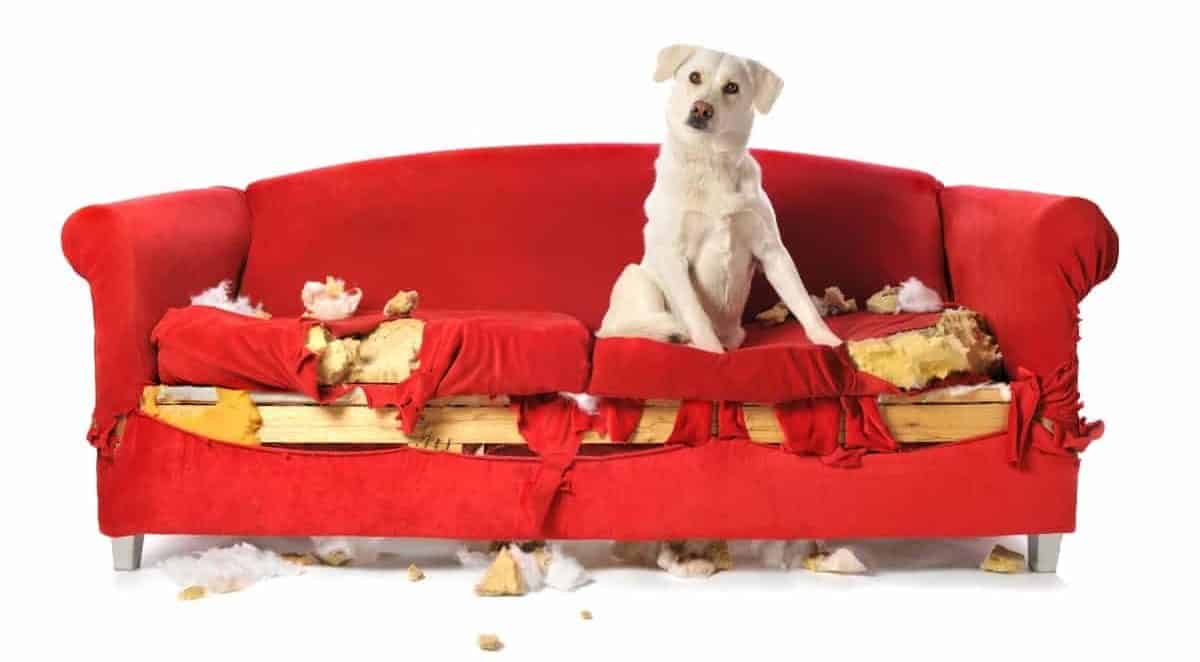
Labrador Behavior Problems
In this article, you’ll learn what causes your Labrador to misbehave. But first, let’s look at Labradors’ most common behavior problems and find out how to fix them by changing unwanted behavior.
1. Mouthing / Play Biting
Playful mouthing, nipping, or biting by your Lab puppy can be adorable. But after experiencing it for the first few days of bringing your new puppy home, you’ll want to curb this behavior, especially as your dog’s teeth become razor sharp – and his jaws become stronger!
Labradors mouth due to their ancestry and genetics. Having been bred to retrieve game for hunters, they naturally enjoy having things in their mouths. Dogs also mouth during instinctive play, when exploring, or relieve teething discomfort.
Mouthing and play biting are not aggressive – and there is a significant difference between typical play biting and aggressive behavior.
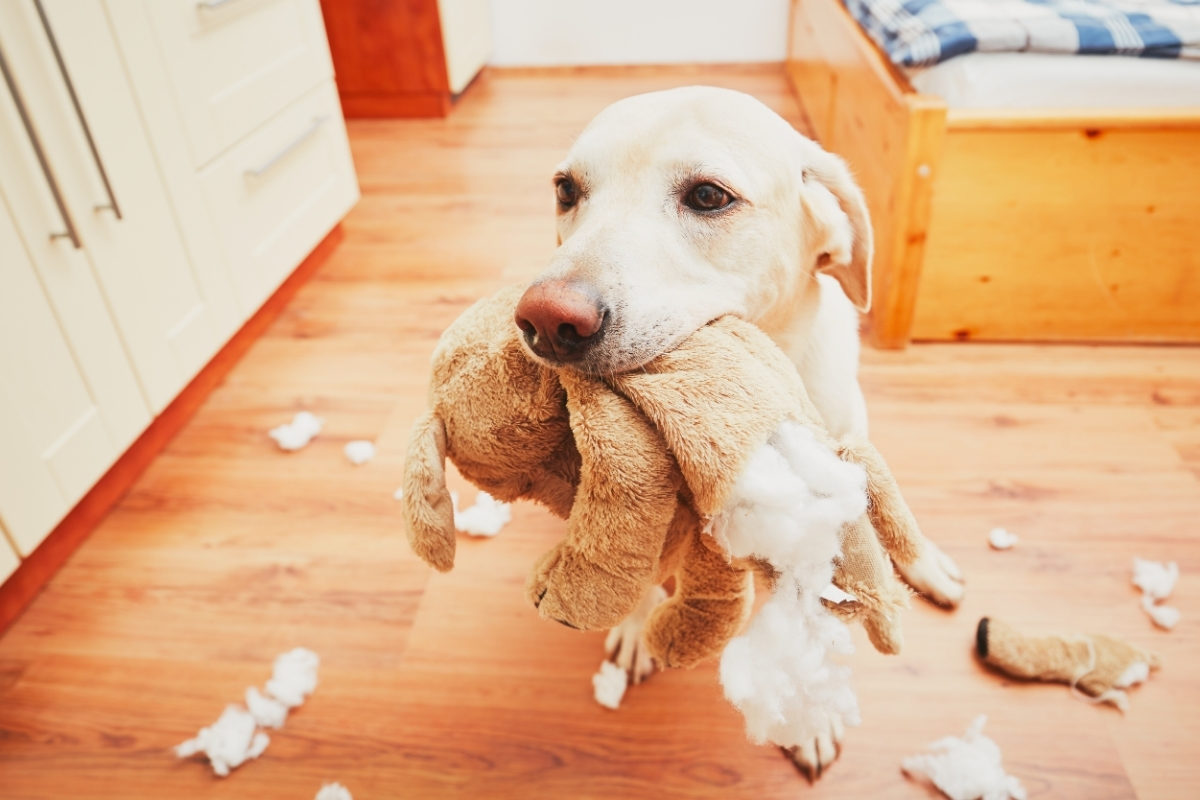
How Do I Stop My Labrador From Mouthing?
Adopt an immediate preventive training approach to prevent innate mouthing and play biting from becoming an aggression problem.
But how?
To stop a Labrador from mouthing, teach him his bite inhibition. This is where he learns to control the force of his mouthing. Let out a high-pitched yelp, such as “OUCH!” then redirect the behavior to a chew toy and use positive reinforcement. You can also teach the “LEAVE IT!” command.
You should initiate bite inhibition when bringing your puppy home, typically around 8 weeks old. All puppies learn their “soft mouth” during playtime with their littermates, and it’s a crucial part of socialization. They soon realize if they bite their littermates too hard, the fun and play stop!
The dam teaches good canine manners and disciplines her puppies when they bite too hard or misbehave. As detailed in this research, removing puppies too soon from their mother can affect the dog’s future behavior.
Your Labrador needs to continue to learn his bite inhibition when you bring him home so that he’s always gentle, even when playing.
So how exactly do you do this?
When teaching your Labrador puppy bite inhibition, make a sharp cry when he mouths or bites you and continue until he lets go. Quickly redirect the behavior using a chew toy, and reward him with a treat and lots of verbal praise.
Continue to do this until your pup stops biting or learns to bite without hurting. You are undoubtedly on the right path when you first notice your Lab licking your hand instead of biting.
Labradors are pretty good at learning “soft mouth” due to their history of being selectively bred to retrieve ducks back to their hunters without their teeth damaging the bird and ruining the meat.
2. Excessive Chewing
Most dogs love chewing – it’s instinctive canine behavior. Puppies chew to explore their new environment using their mouths, even before using their visual, auditory, and olfactory senses. They also chew to relieve pain and discomfort when teething, clean teeth, and strengthen jaws.
But sometimes, chewing becomes abnormal or destructive, resulting in your Labrador destroying your couch, cushions, furniture, possessions, clothing, and shoes.
Labradors engage in destructive chewing due to inadequate obedience training as a puppy, seeking attention, habit, easing hunger, boredom, lack of exercise, and insufficient mental stimulation. They also chew due to loneliness, fear, separation anxiety, malnutrition, or OCD.
Don’t yell or punish your dog for destructive chewing, especially after the event. You will only cause your Lab to fear and resent you and cause confusion and aggression.
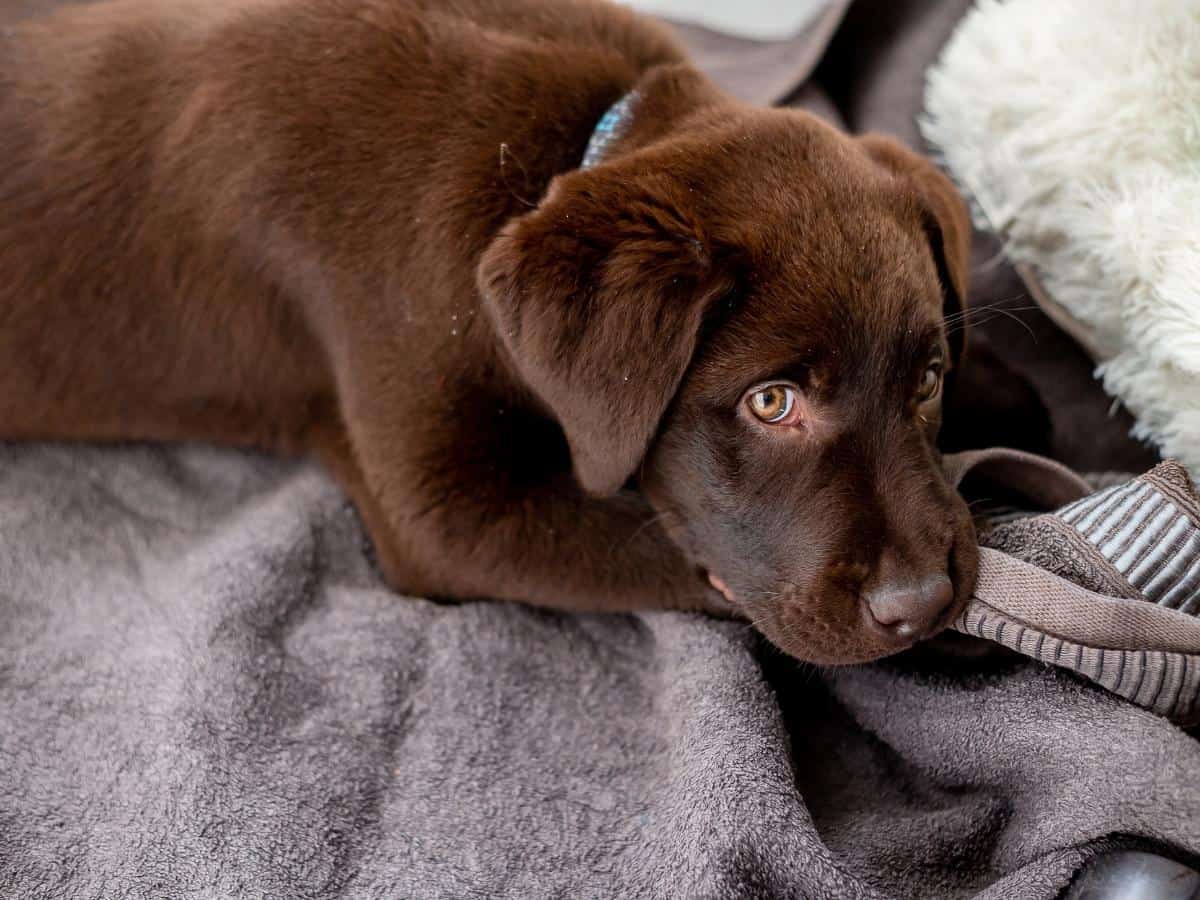
How Do I Stop My Labrador From Chewing Everything?
As with the causes, the solutions for excessive-destructive chewing in your Labrador can be varied.
To stop a Labrador from chewing everything, train him from an early age by redirecting his chewing to alternatives such as chew toys, treats, or bones. Ensure he has sufficient exercise, isn’t bored, and rule out medical conditions. Fix incomplete training, or seek the help of a professional trainer.
Essentially, you need to provide your Labrador with alternative chew toys that can also serve as bites. Consider these two from Amazon:
- KONG Puppy Toy is made from soft rubber designed for growing teeth and gums but durable enough to withstand the natural desire to chew. This multi-functional toy can be used as a fetch toy or treat-dispensing toy to stuff with delicious treats or peanut butter.
- Benebone Durable Wishbone Dog Chew Toy is good for the strong chewer that your Labrador puppy can be. It allows a good grip from the wishbone shape and lasts for weeks. There is a choice of 100% real bacon, chicken, or peanut flavors. You also have various sizes to choose from as your puppy grows.
Here are some other helpful suggestions to stop your Labrador from chewing:
- Puppy-proof your home. Control your puppy’s environment by restricting his movements around the house, allowing you to supervise him. You can use a playpen or baby gates to section off part of the house or use a long leash and keep him tied to your waist.
- Retrain your dog. If you think basic training was poorly done or incomplete during puppyhood, you may need to retrain your Labrador. Consider the help of a professional trainer.
- Give your Lab a bone to chew. A raw beef shank bone larger than your dog’s muzzle is the best as it won’t splinter and cause mouth injury, choking or blockages. Always supervise your dog when giving a bone.
- Feed frozen treats or ice cubes. These help your dog to find some relief from sore and painful gums. Try frozen strawberries or raspberries as an alternative healthy treat. Here’s a list of 29 fruits that your Lab can safely eat.
- Lots of daily exercise. Ensure your Lab has the recommended 2-hour exercise daily for an adult, which could consist of morning and evening walks or runs, and play and fun games at other times. Puppies should receive 5 minutes of exercise per month of age, twice a day.
- Consider health issues. If you suspect your Lab’s chewing is more than poor behavior and have tried all other remedies, consult your vet to rule out stress, anxiety, malnutrition, OCD, or other medical problems.
Learn How To Stop Your Dog From Chewing In This Video…
At What Age Do Lab Puppies Stop Chewing?
Labrador puppies will generally stop chewing, due to teething, around six months of age once the discomfort has gone. Older puppies may also go through a chewing stage up to 12 months old. As long as you keep normal chewing behavior from becoming destructive, your puppy should outgrow this chewing.
3. Excessive Eating
It’s no secret that Labradors love their food. They are easy to train due to their intelligence, but also their desire for food or treats during training sessions makes training easy. Many owners find it tricky to keep their Lab at a healthy weight.
So what’s the deal?
Labradors eat so much and are highly motivated by food due to genetics, illness, lack of nutrients, boredom, or anxiety. Many are obsessed with food due to a specific mutated gene, the POMC. This gene, responsible for appetite, body fat, and weight, is commonplace in the obesity-prone Labrador.
The University of Cambridge, UK, found that a POMC mutation is typical in the obesity-prone Lab. The only other breed to have this mutation is the Flat-Coated Retriever.
Your Lab may also be eating so much food to relieve boredom, stress, anxiety, or due to a diet deficient in nutrients. You can learn more about separation anxiety in the next section.
Furthermore, specific health issues can cause increased appetite and cause your dog to gain weight. Labradors are prone to hypothyroidism and may become obese despite normal or increased hunger.
Pica is a disorder where dogs eat inedible objects such as rocks, dirt, wood, socks, toys, or even poop! It can is caused by nutritional shortcomings, starvation, or psychological issues such as anxiety, stress, attention-seeking, or OCD. If your Labrador is snacking on rocks and dirt, he may be suffering from pica.
Check out this article for greater insight; Why Do Labradors Eat So Much?
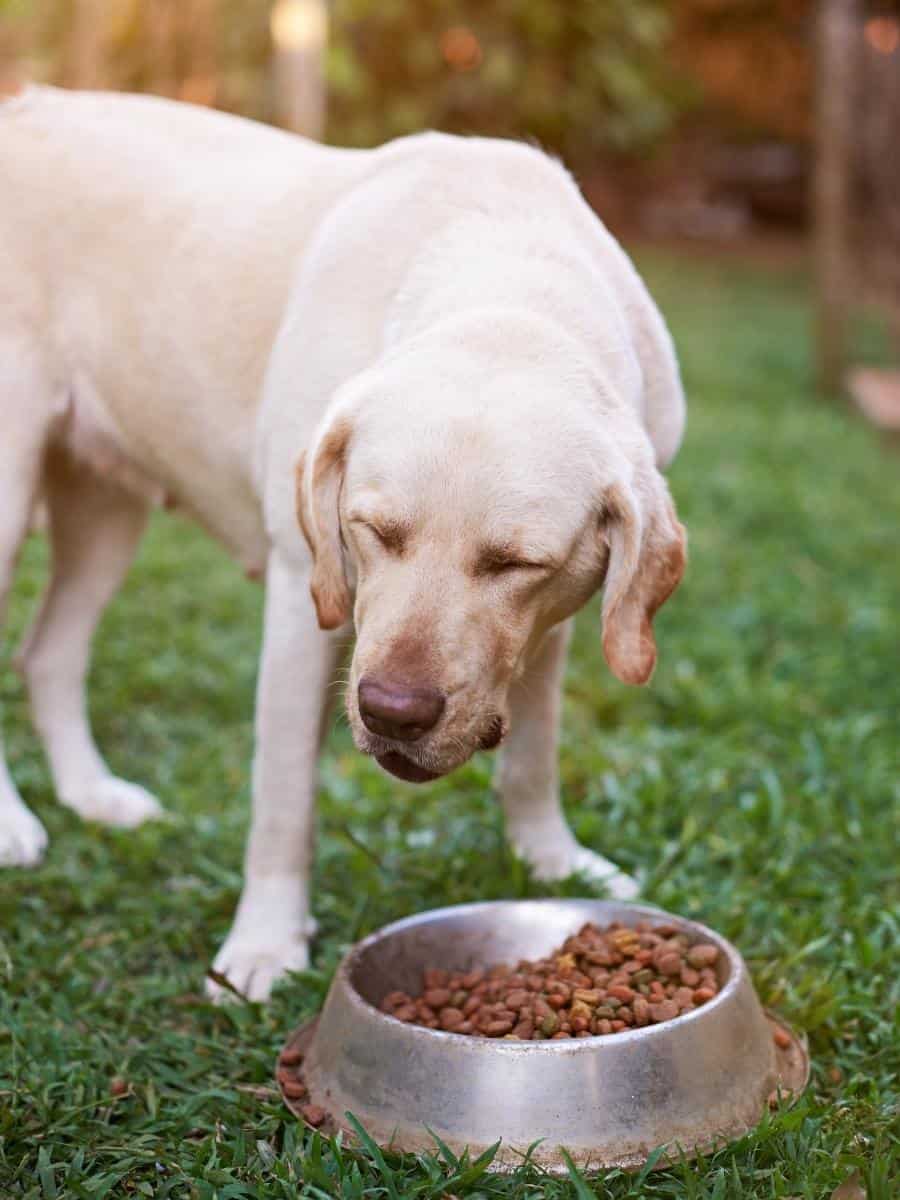
How Do I Stop My Labrador From Eating So Much?
There are many ways to stop your Labrador from overeating. However, your priority is to find out why he is overeating or munching everything in sight, maybe with the help of your vet. You can then formulate a plan together. Here are some suggestions.
To stop a Labrador from eating so much, feed a highly nutritious and balanced diet, keep a feeding schedule, monitor portions and weight, and feed alternative healthy treats. Don’t give in to begging eyes, put your dog in another room at your mealtimes, and rule out medical causes.
Let’s delve a little deeper into some of these suggestions:
- Keep to a schedule and monitor. Dogs are creatures of habit and love routine. Stick to daily feeding times and monitor portion sizes and calories. Do not allow free feeding, and have your Lab regularly weighed.
- Ensure your dog is eating highly nutritious food. If your Labrador’s diet is deficient in specific nutrients, he might be inclined to find other food, such as scraps, or even raid the garbage! Ensure your dog has a good-quality nutritious diet. Check out my article on the best diet for Labradors for a ton of nutrition information, type of diet, and more.
- Alleviate boredom. Make sure you’re giving your Lab the care and attention he needs. Not only does he need lots of physical exercise, but lots of cognitive stimulation too. Lots of chew toys and interactive toys will keep your dog entertained.
- Feed alternative healthy treats. Many store-bought dog treats are full of calories and additives and offer little nutritional value. You can choose some good healthy treats, but fruits and vegetables are better options.
- Dog-proof your home. Don’t leave tempting food lying around on tables or kitchen worktops, and make sure your Lab can’t get in the garbage to rummage for scraps.
- Muzzle your dog. If your Labrador tends to eat anything he finds while out on a walk, consider using a muzzle. You can also use the “LEAVE IT” command, as long as you have him in your sight!
4. Separation Anxiety
Canine separation anxiety purely means the dog cannot cope with being apart from his owner or family. But are Labradors prone to separation anxiety?
Labradors are prone to separation anxiety due to their temperament. They are social, affectionate, friendly, good-natured, and high-energy, and soon get bored. They love to be around their pack, which means you! If they are left alone for too long, they will suffer from separation anxiety.
Dogs with separation anxiety will find something to relieve their fear, worry, and stress, so they often resort to destructive behavior. General symptoms are destructive chewing, house soiling, digging, escaping, destroying furniture, barking, and howling. Repetitive behavior, pacing, and self-harm may also occur.
It’s essential to know how your dog communicates with you to recognize behaviors such as canine separation anxiety.
Watch our video below about separation anxiety in dogs…
How To Stop Separation Anxiety in Labradors
Working out why your Labrador reacts badly to being left alone can be difficult. But, there are some things you can do to relieve your dog’s distress when he’s alone – and help both of you feel better.
Keep departures and arrivals low-key to stop separation anxiety in your Labrador. Leave your dog in a relaxing and comfortable spot with his favorite interactive toys and chew toys. Train him using behavior modification methods such as desensitization and counter-conditioning.
Here are some other helpful tips and tricks to stop separation anxiety in your Labrador:
- Don’t leave your dog alone for too long. You should never leave your Labrador alone for longer than four hours, even less for young puppies. Check out my guilt-free guide, How Long Can Labradors be Left Alone?
- Consider alternatives to prevent or treat separation anxiety. Reduce the time that your Lab spends at home alone by hiring a dog sitter, walker, or professional trainer. Have friends and family call around, use local doggie-day care, and work from home if possible.
- Keep your dog occupied while you’re away. Ensure you leave your dog’s favorite chew and interactive toys out. Check out the Outward Hound Dog Brick Interactive Treat Puzzle Toy from Amazon if you’re stuck for ideas. This toy will keep your dog entertained and is great fun, especially when he finds the treats!
- Stay connected with your Lab. It’s easy to stay hooked up to your Labrador using cameras, such as the Furbo Dog Camera from Amazon. I like this one as you can follow your dog’s activity using the live stream video, but you can also toss a treat to him! How cool is that?
- Use behavior modification techniques. Counter-condition your Lab by training him not to associate departure cues, such as the sound of your keys jingling. The aim is to teach him not to worry about your exit by associating the sound of your keys with getting a treat. Hold back on the doggie kisses and leave!
- Use desensitization techniques. Gradually teach your dog to cope with being alone by carefully exposing him to being alone in small steps. For example, start by making progressive departures of 1-5 minutes when you leave your Labrador and progressively increase. Train your dog to be alone from an early age. I would leave my girl in her crate for a few minutes at a time at eight weeks old and gradually increase.
- Treat with medication. Both anti-anxiety medicine and natural supplements can help treat separation anxiety in dogs. Your vet can advise you of the best treatment plan for your dog.
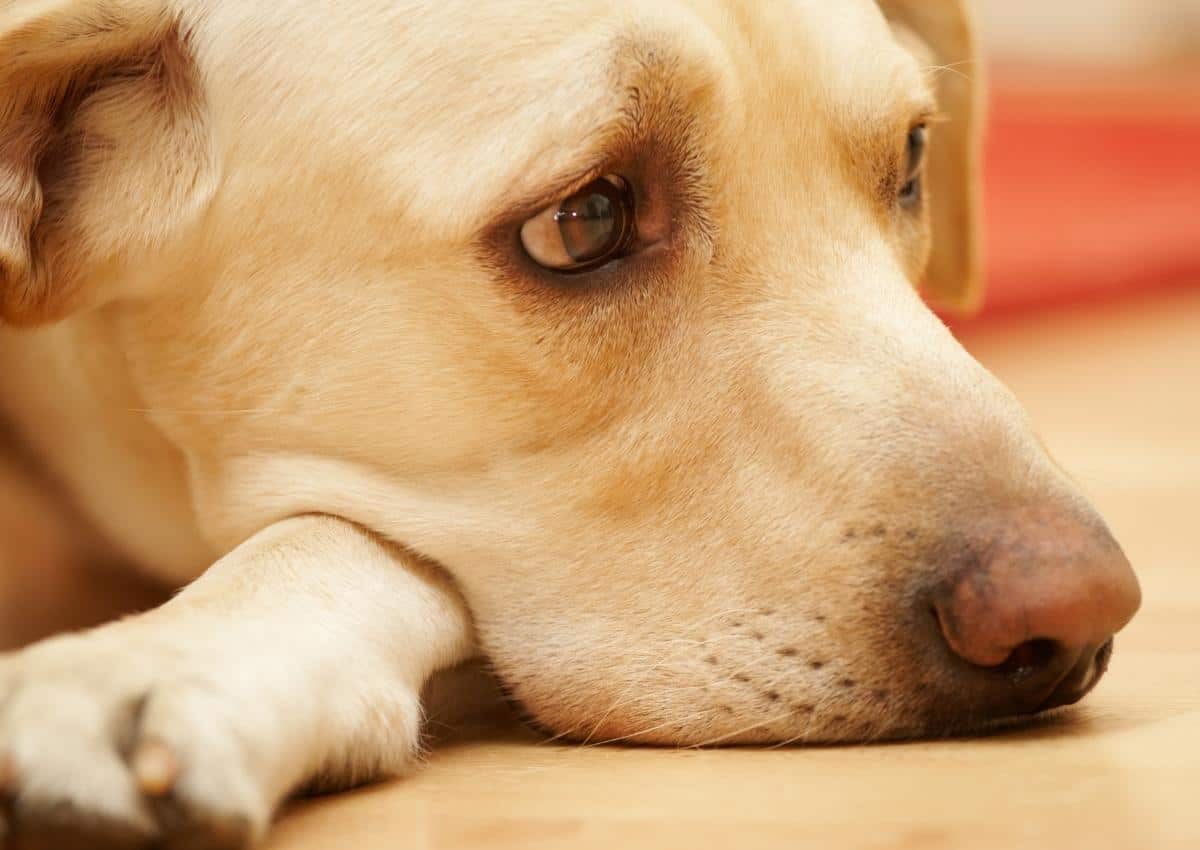
5. Labrador Urine Marking Behavior
Does your Labrador stop on every street corner to pee a small amount? Spraying is instinctive dog behavior, but why do Labradors mark their territory?
Labradors mark their territory to leave their scent and communicate to other dogs by sending a message that it’s their territory. Dogs will leave their scent on new smells or near where other dogs have urinated. Urine communicates the reproductive status and status rank of the dog.
For example, male Labradors will urine mark on the side of a building where there’s a female in heat to tell other males to keep away. Females will also scent, but only when they’re in heat to attract a male.
But here’s the kicker…
Urine marking is inappropriate and becomes a problem behavior when done inside the house! Many owners find this conduct hard to understand and don’t appreciate this calling card being left indoors. So, why do Labradors mark their territory inside?
Labradors mark their territory inside when sexually active, especially in unneutered dogs, or claim ownership of you, e.g., by urinating on your partner’s bag. Dogs may also scent inside when there’s a new pet in the home, if they can smell another dog on you, or if they’re suffering from anxiety.
How Do I Stop My Labrador From Urine Marking?
To stop your Labrador from urine marking inside, neuter while young, keep new and unfamiliar items out of reach, supervise your dog or use a crate. Increase bonding with new pets or family, eliminate anxiety, rule out other medical reasons, fully clean up the mess, and consult a canine behaviorist if needed.
Thoroughly clean the areas your dog has marked using an enzymatic cleaner to eliminate the smell and prevent further scenting.
Read more: How Long Can You Leave a Lab in a Crate? Myths vs. Reality!
6. Barking at Other Dogs
Barking is a typical communication behavior in dogs, and Labradors are known to be naturally vocal. Nonetheless, when your Lab has developed an unfortunate habit of barking at other dogs, this may cause you to wonder why?
Labradors bark at other dogs due to a lack of socialization and becoming fearful or anxious. Other reasons are insufficient or incomplete training, being protective or territorial of you, or generally being social or excited and wanting to greet or play, especially if under-exercised or stimulated.
Read More: Labrador Barking at Other Dogs? How to Stop Barking.
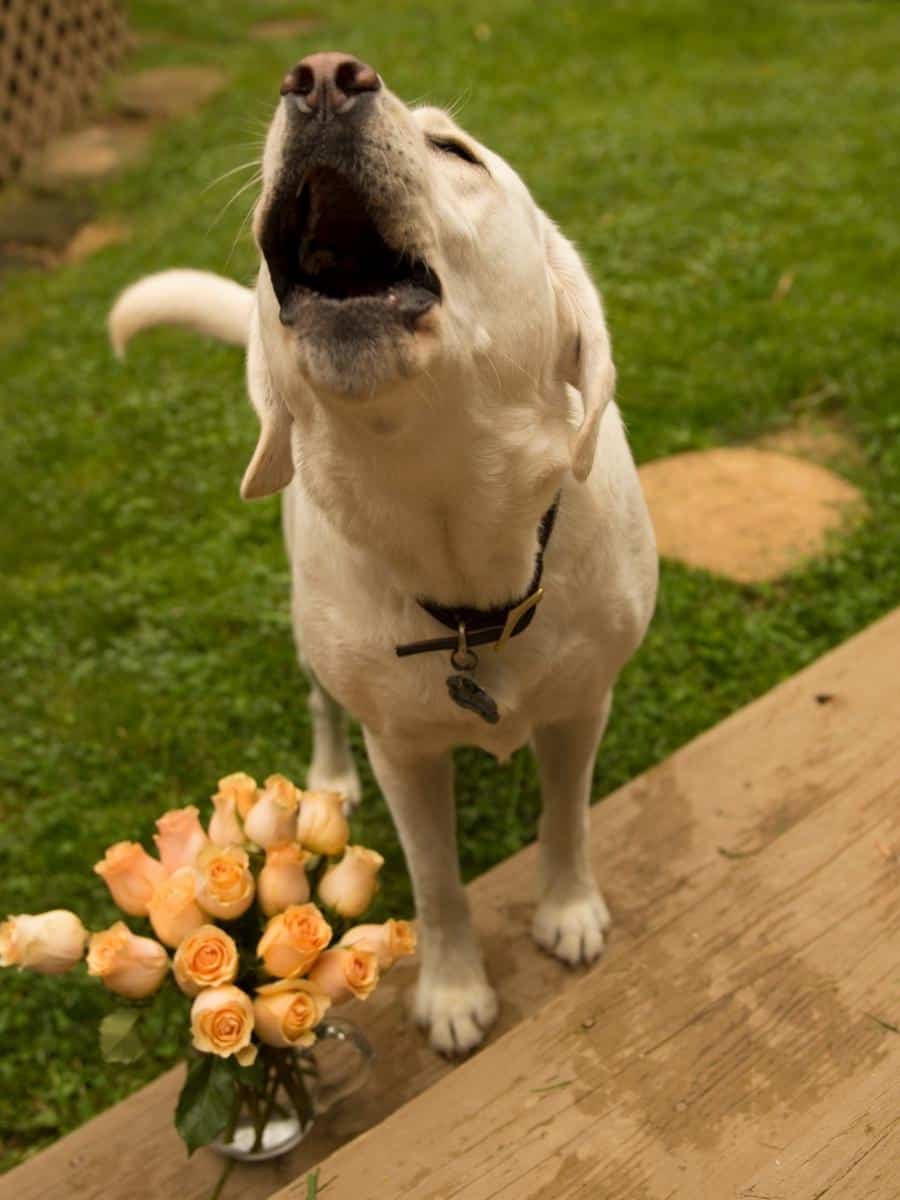
How Do I Stop My Labrador From Barking at Other Dogs?
Barking at other dogs is an everyday behavior issue in many breeds, so you’re not alone. Don’t worry, though, as there are things you can do to prevent this embarrassing behavior.
Stay relaxed, and don’t tense the leash to stop your Labrador from barking at other dogs. Distract him with treats BEFORE he starts to bark. Work on obedience training and positive reinforcement, allowing time, patience, and consistency. You can also teach your dog the “quiet” command.
The best time to correct your Labrador from unwanted barking at other dogs is right BEFORE it occurs. Learn to anticipate when your dog is about to bark, and at this PRECISE MOMENT, get his attention on YOU by using VOCAL commands and lots of EYE CONTACT and then quickly reward him with a TREAT.
Avoid gimmicks such as bark collars and sprays designed to teach your Labrador not to bark, as these only tackle the symptom and not the cause of the problem.
Watch How To Stop Barking In This Video…
7. Rolling in Fox Poo
Bathing your dog can be a challenging task. It’s also an extra hassle if he’s covered in awful-smelling dirt!
Labradors roll in fox poo as it’s a natural behavior. Their ancestors would disguise their scent to confuse their prey. Dogs also mark their territory by leaving their scent behind and communicating their rank or dominance to other dogs. They also enjoy leaving their smell around.
Your dog’s nose is powerful – his sense of smell is the dominant sense due to the millions of sensory receptors in his nasal cavity. The pungent scent of the fox is so tempting to your Labrador that he just can’t resist rolling in it!
How Do I Stop My Labrador From Rolling in Fox Poo?
It’s difficult but not impossible to curb instinctual dog behaviors. Sometimes, prevention can be your best tactic!
To stop a Labrador rolling in fox poo, try to prevent it by keeping him away from known areas frequented by foxes. If your dog suddenly puts his nose to the ground, anticipate he may have picked up on the strong scent of fox poo and quickly distract him away. You can also teach the “LEAVE IT!” command.
8. Resource Guarding
Resource guarding is when your Lab displays certain behaviors such as snarling, growling, biting, and lunging over food, favorite toys, or space, e.g., crate, or dog bed. It is also known as canine possessive aggression, and your dog might growl at you if you go near their treasured possessions or run away with the item.
You can learn more about this behavior problem here, Resource Guarding in Labradors: The Do’s and Dont’s.
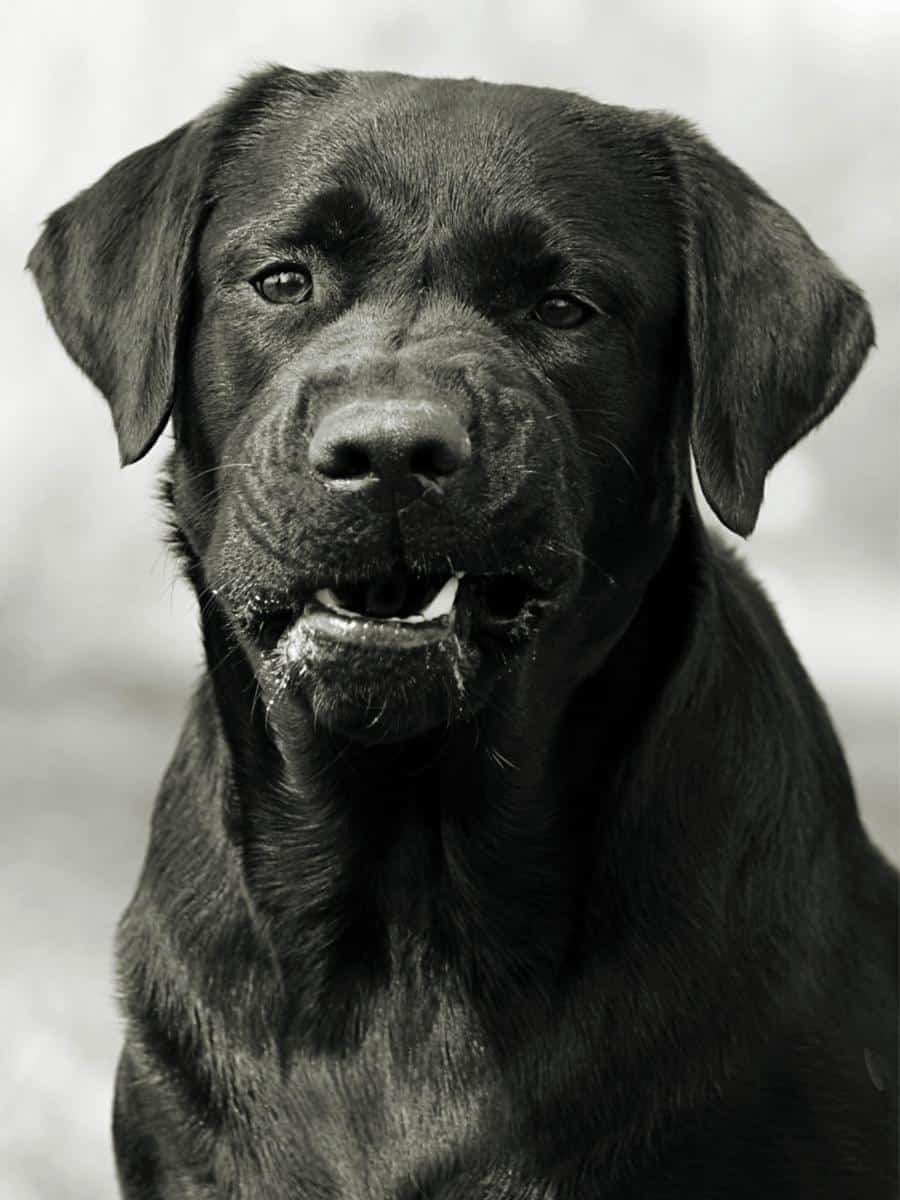
How Do I Stop My Labrador From Resource Guarding?
Although resource guarding is natural canine behavior, it is not desirable. Some owners prefer to try and change the behavior in addition to the usual precautions of keeping people safe, especially children. Early and frequent training can help prevent resource guarding before it becomes a significant problem.
Nonetheless, here are some steps to stop your Labrador from resource guarding:
- Consult a certified trainer or dog behaviorist.
- Use desensitization and counter-conditioning techniques.
- Don’t leave items lying around your dog becomes possessive over, e.g., socks, chew bones.
- Don’t punish growling behavior.
- Don’t disturb your Lab when he is eating.
You can also teach your Lab essential training commands such as “LEAVE IT,” “COME,” or “KENNEL.”
Causes of Labrador Behavior Problems
Although many dog behaviors are instinctual, which we shouldn’t try to curb, many are unwanted as we don’t want to see or experience them. Instead, we try to redirect the behavior. But often, the issue is with the owners’ unrealistic expectations and insufficient or incomplete training.
Like all other breeds, Labradors have innate behavioral tendencies that are unique. Think of their overwhelming friendliness and easy-going nature. They are a good first dog but make a hopeless guard dog!
Your Labrador will develop into the dog that you train him to be. So when socialization and training are not done correctly, behavior problems will inevitably occur.
Watch How To Eliminate 90% of Dog Behavior Problems In This Video…
Let’s now investigate the most common causes of behavior problems in Labradors. And as you saw in the video, the first one is a lack of structured exercise!
Insufficient Exercise and Stimulation
The Labrador Retriever is a high-energy dog requiring at least two hours of daily exercise. Leash walking alone will be insufficient. Incorporate a combination of swimming, agility, frisbee, hiking, fetch, and off-leash running in a safe area. Your dog will also need lots of cognitive stimulation and interactive play.
If you turn your Labrador into a couch potato, he’s sure to have behavioral issues, which usually manifest in destructive behavior.
Research has confirmed that less active dogs will demonstrate behavior problems than well-exercised canines. For example, this study revealed that active dogs had fewer behaviors than sedentary dogs, such as “turning on themselves” and “mounting.”
After all, a tired dog is a happy dog!
Genetic Disposition to Certain Behaviors
It has been scientifically proven that dog behavior has both genetic and environmental key factors. This is documented in a study on the genetic examination of behavior traits in dogs whereby the German Shepherd breed was utilized.
The research confirmed the theory that dog behaviors are complex traits influenced by multiple genetic and non-genetic factors.
In simple terms, your dog may inherit genes that urge him to retrieve. If we take the Labrador as an example, it’s no surprise that their most inherited trait is retrieving – after all, the clue is in their name!
Your Lab may inherit genes urging him to find and recover, just like his ancestors, who retrieved ducks from the hunt. He has a natural desire to bring you back things. Unfortunately, this can sometimes include dead birds or squirrels!
However, this does not mean that you cannot subdue the behavior through training.
It can be beneficial to check with the breeder whether your puppy’s parents are from field lines (working) or show-bred lines. Field-bred Labradors are typically higher energy and more boisterous.
Another inherited attribute of the Labrador is their strong pack drive. It’s believed to contribute to why they are so friendly and good-natured. Extremely social dogs with high pack drives tend to follow their owners everywhere, even to the bathroom!
One drawback to this trait is that they may find it difficult when left in kennels for vacations. Labs may also suffer from separation anxiety when left alone, but we’ll cover that later.

Poor Puppy Socialization
Poorly socialized puppies grow into badly behaved Labradors. Science has determined that between 4 and 14 weeks is the most crucial time in a puppy’s socialization process. This is when the puppy acquires nearly all of his adult sensory, motor, and learning abilities. If a puppy is not socialized well, he will become a problematic and untrainable adult.
Proper socialization involves exposing your Labrador to many different environments where he’ll learn how to interact positively with other people and animals. This makes him more confident and calm than anxious and aggressive in unsocialized and poorly trained dogs.
Incomplete Obedience Training
Obedience training is crucial in helping your Labrador understand what you expect of him. He’ll start by learning basic commands such as no, sit, down, come, stay, etc. Then, he can progress to more advanced training, such as sit-stay, wait, speak, roll-over, and other tricks.
Many new dog owners believe a week or two of training after bringing their puppy home is enough. Not so!
Although the Labrador is one smart cookie, you’ll need patience and consistency for a few months to teach him all the basic and advanced commands he needs to be a well-behaved dog.
Leaving unfinished training means your dog won’t have adequately mastered the commands, and you’ll have to keep starting again. Consistency also means using the exact words to command specific behavior from your Labrador. Otherwise, you’ll only confuse him.
I have this helpful beginner’s guide to obedience training using positive reinforcement, How to Train an 8- Week Old Labrador Puppy.
Aversive Training Methods
Punishing your Labrador to make him learn good behavior will only result in the opposite. Your best friend will be so confused and only grow to resent and fear you.
Research suggests that aversive training methods may be less effective in teaching good behavior and will harm your Labrador’s physical and mental health. They can also cause aggression and escaping behavior.
Positive reinforcement, also known as reward-based training, creates the best behavior in dogs because you encourage your pet to repeat good conduct by consistently rewarding him. It simply means giving a reward to increase the frequency of response.
Read more: How to Discipline a Labrador: What Not to Do!
Hormonal Effects and Neutering
Testosterone is often associated with aggression in male dogs, but studies have proved mainly inconclusive.
Neutering is the surgical removal of the male testes or female ovaries. Research results from a large sample of over 13,795 dogs show that neutering does not necessarily reduce aggression.
This interesting study showed no significant increase in aggression in sterilized dogs, except for those between 7 and 12 months of age. Scientists can still not explain this.
Additionally, this study discovered that other hormones cause aggression in dogs. Oxytocin (a hormone associated with social bonding and sexual reproduction) and Vasopressin (which maintains the concentration of salts and glucose in the blood plasma and the volume of water in the fluid surrounding cells) can negatively impact dog behavior.
The bottom line is that hormonal dynamics can be an underlying reason for your Labrador’s behavior problems.
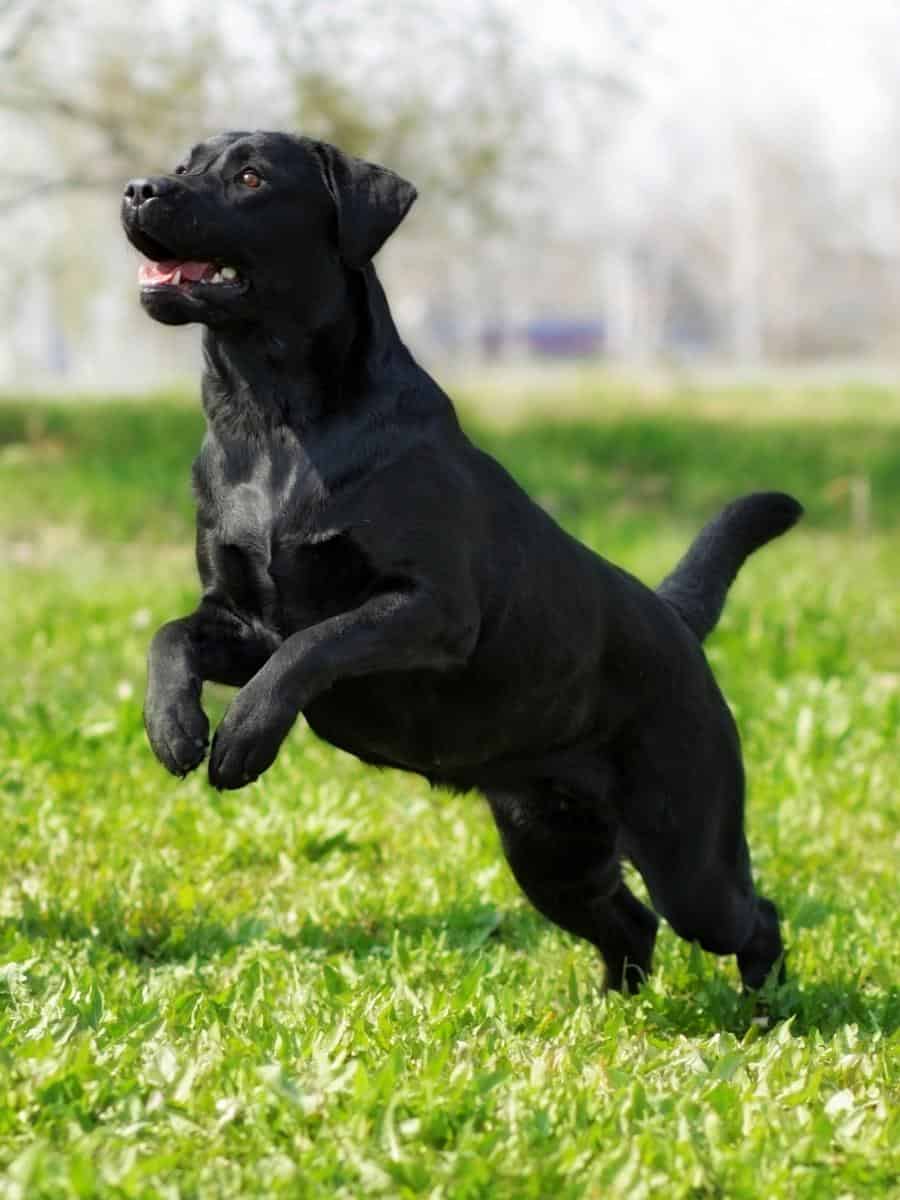
Letting Your Labrador Run The Show
What if you heard a Labrador owner say his dog never badly behaves, only to discover that the owner allows the dog to have the upper hand? Would you call that a well-behaved dog? Failing to set boundaries can be another reason your Labrador has behavioral issues.
Dominance aggression is when the dog will try to be the alpha or single out one particular member to dominate.
I can certainly relate to this, as my dog tried for months to boss me. Although I was as firm as the male family members, she never wanted to dominate them!
I wondered if I had done anything wrong or different from the others, as I certainly hadn’t let her call the shots. However, I didn’t need to worry as I learned that less than half (40%) of dominance aggression situations are linked to dog owners who have spoiled their dogs or done very little obedience training.
Such a dog will show dominance aggression when a person tries to set boundaries, such as at the vet’s. Spoiling your dog is one of the major factors leading to dominance aggression in dogs.
Medical Conditions or Malnutrition
Your Labrador may show behavior problems due to medical issues, either physical, psychological, or both. For example, dogs with obsessive-compulsive disorder (OCD) may show tail chasing, circling behavior, vocalization, pica, self-directed aggression, and self-mutilation through biting.
In this study, the most common clinical features of OCD in dogs were self-mutilation or grooming.
Other medical conditions include injury and post-operative pain, which can trigger aggressive behavior.
A hungry or malnourished Labrador can also cause behavior problems such as destructive chewing. Sometimes a history of starvation experienced by rescue dogs may leave them with an eating disorder in which they seek nourishment from non-food items known as pica.
Let’s Wrap This Up!
Owning a Labrador Retriever is exciting and rewarding for most owners. However, behavior problems associated with the breed can sometimes make it a challenge.
While owners’ actions, specifically insufficient socialization, training, exercise, and guidance, generate most Labrador behavior problems, some can be due to genetics, and underlying health issues can cause others.
What is most encouraging is knowing that you can manage these behavior problems.
Exercise, training, eliminating triggers, and seeking a canine behaviorist are helpful and constructive ways to help your Labrador overcome his behavior shortcomings. These issues won’t rectify themselves overnight. You must practice patience and consistency every day and work at it.
Remember, though, a dog behaviorist or trainer’s job is to train the dog – and the human too!
Good luck!





